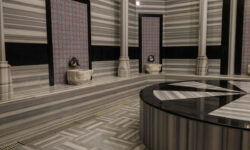ForeverLawn Golf Greens 

ForeverLawn Golf Greens present an exceptional solution for avid golfers and enthusiasts seeking to elevate their game to new heights. These innovative synthetic turf surfaces blend the beauty of a natural golf course with the durability and low maintenance requirements of artificial materials. Crafted with meticulous attention to detail and designed to replicate the finest putting greens, ForeverLawn Golf Greens offer an unparalleled playing experience that enhances precision, consistency, and overall enjoyment. Whether for residential or commercial use, these state-of-the-art golf greens promise aesthetically pleasing landscapes that withstand rigorous play, providing golfers with a superior alternative to traditional grass surfaces.
ForeverLawn Golf Greens: Enhancing Your Putting Experience
If you’re an avid golfer seeking to take your putting game to the next level, ForeverLawn Golf Greens can help transform your backyard or commercial space into a professional-grade golfing haven.
ForeverLawn Golf Greens specializes in designing and installing synthetic golf greens that closely mimic the look, feel, and performance of natural grass. These high-quality artificial surfaces offer numerous advantages for golf enthusiasts:
- Consistent Performance: ForeverLawn Golf Greens provide a uniform playing surface, ensuring consistent ball roll and predictable movement. This allows golfers to work on their technique with precision and accuracy.
- Low Maintenance: Unlike natural grass, synthetic golf greens require minimal upkeep. They do not require mowing, watering, or fertilizing, saving you time and money in the long run.
- Durability: ForeverLawn’s advanced materials are engineered to withstand heavy use and extreme weather conditions. This means you can practice your putting year-round without worrying about damage or wear and tear.
- Versatility: ForeverLawn offers customizable options to suit your specific needs. Whether you want a small putting green in your backyard or an expansive golf course for a commercial facility, they can create a tailored solution that fits your space.
With ForeverLawn Golf Greens, you can enjoy the convenience of practicing your putting skills whenever you want, right in the comfort of your own property. These synthetic greens are also an excellent investment for golf courses, resorts, and entertainment venues looking to enhance their amenities and attract more players.
Experience the joy of perfect putts and improve your game with ForeverLawn Golf Greens. Contact them today to discuss your requirements and explore the possibilities of transforming your space into a golfer’s paradise.
Synthetic Golf Greens: The Perfect Solution for Golf Enthusiasts
When it comes to golfing, the quality of the playing surface can greatly impact the overall experience. Traditional natural grass greens require extensive maintenance and care, making them costly and time-consuming to upkeep. This is where synthetic golf greens come in as a game-changing solution.
Synthetic golf greens, also known as artificial putting greens or artificial golf greens, are specially designed surfaces that mimic the look and feel of real grass. These greens are made from high-quality synthetic materials, such as polypropylene or nylon, which provide durability and a consistent playing surface.
One of the major advantages of synthetic golf greens is their low maintenance requirements. Unlike natural grass, they don’t require regular mowing, watering, or fertilizing. This not only saves time but also reduces water usage and eliminates the need for harmful pesticides or herbicides. Golfers can enjoy a pristine green all year round without worrying about maintenance tasks.
Another benefit of synthetic golf greens is their versatility. They can be installed both indoors and outdoors, allowing golf enthusiasts to practice and play regardless of weather conditions. Whether it’s a backyard putting green or a professional golf course, synthetic greens offer consistent performance and a true roll for improving one’s game.
Furthermore, synthetic golf greens are highly customizable. They can be tailored to fit specific design preferences and skill levels. Different slopes, undulations, and even hazards like sand traps can be incorporated into the design, providing an authentic golfing experience. Golfers can practice different shots and improve their skills in a controlled environment.
Overall, synthetic golf greens have revolutionized the way golf is played and practiced. They provide a cost-effective, low-maintenance alternative to natural grass greens, offering consistent performance and customization options. Golf enthusiasts can enjoy their favorite sport year-round, honing their skills and experiencing the joy of golf in the comfort of their own surroundings.
Artificial Putting Greens
Artificial putting greens are synthetic surfaces designed to mimic the look and feel of natural grass greens found on golf courses. These specially constructed turfs provide golfers with a consistent and reliable surface for practicing their putting skills.
One of the key advantages of artificial putting greens is their low maintenance requirements. Unlike natural grass, they do not require mowing, watering, or fertilizing. This makes them an ideal choice for homeowners, golf enthusiasts, and practice facilities that want to have a putting green without the hassle of regular upkeep.
Artificial putting greens are typically made from synthetic fibers that are designed to replicate the texture and performance of real grass. The turf is installed over a compacted base, which provides stability and proper drainage. Advanced systems may also include additional features like undulations, bunkers, or fringe areas to further enhance the playing experience.
These synthetic greens offer consistent ball roll and speed, allowing golfers to practice putting strokes with precision. Many artificial putting greens can be customized to accommodate various skill levels and preferences. Some models even allow for adjustable speeds, giving players the ability to simulate different green conditions.
Artificial putting greens are not only limited to professional golf courses; they are also popular among homeowners who want to create a dedicated practice area in their backyard. With the right design and installation, these greens can blend seamlessly with the surrounding landscape, providing a visually appealing and functional space for honing putting skills.
Creating Professional Backyard Golf Greens
Backyard golf greens offer golf enthusiasts a convenient and accessible way to practice their game in the comfort of their own homes. These greens can be custom-designed to simulate the conditions of professional courses, providing an excellent training ground. Here are some key points to consider when creating a professional backyard golf green:
- Site Selection: Choose a suitable location in your backyard that offers enough space for the green. Ensure the area is relatively flat and free from obstacles.
- Design and Layout: Plan the layout of your green, keeping in mind the desired size and shape. Incorporate features like undulations, bunkers, and fringe areas to mimic the challenges found on a real golf course.
- Drainage: Proper drainage is crucial to prevent water accumulation and maintain optimal playing conditions. Install an effective drainage system during the construction process.
- Grass Selection: Choose a high-quality grass variety suitable for golf putting surfaces, such as Bermuda grass or bentgrass. Research the specific grass requirements for your climate zone to ensure proper growth and maintenance.
- Green Construction: Follow professional construction techniques to build a solid foundation for your green. This may involve excavation, grading, and installation of a base layer, such as gravel or sand, before laying the turf.
- Maintenance: Regular maintenance is essential to keep your backyard golf green in pristine condition. Tasks include mowing, watering, fertilizing, and aerating the turf. Consult with experts or golf course professionals for guidance.
- Additional Features: Enhance your backyard golf green with auxiliary features like practice nets, chipping areas, or target flags to simulate real golfing scenarios and improve your overall game.
Remember, creating a professional backyard golf green requires careful planning, attention to detail, and ongoing maintenance. With the right resources and dedication, you can enjoy the convenience of practicing your swing anytime right in your own backyard!
Residential Golf Greens
Golf enthusiasts who wish to practice their game without leaving the comfort of their homes often opt for residential golf greens. These are custom-designed putting surfaces that mimic the look and feel of real golf courses. They provide homeowners with the opportunity to improve their golf skills while enjoying the convenience of playing on their property.
Residential golf greens are typically constructed using synthetic turf or natural grass, depending on the homeowner’s preferences and maintenance requirements. Synthetic turf offers a low-maintenance option that remains green and playable throughout the year, while natural grass provides a more authentic golfing experience but requires regular care and upkeep.
A well-designed residential golf green incorporates various elements found on professional golf courses, such as undulating terrain, strategically placed bunkers, and challenging putting slopes. Homeowners can customize their greens to match their skill level and desired level of difficulty.
Creating a residential golf green involves careful planning and construction. The process usually begins with site evaluation and design, considering factors like available space, drainage, and sunlight exposure. Professional installers then prepare the ground, ensuring proper leveling and compaction before installing the chosen turf or grass. Additional features like tee boxes, fringe areas, and chipping zones can also be included to enhance the overall golfing experience.
Residential golf greens offer several benefits to homeowners. They provide a convenient practice area, allowing golfers to hone their skills whenever they want. Playing on a familiar surface can help build confidence and improve consistency in putting and short game techniques. Additionally, having a residential golf green adds aesthetic appeal to the property and can increase its value.
Overall, residential golf greens offer avid golfers the opportunity to enjoy their favorite sport right at home. With customization options and realistic playing conditions, these greens provide a valuable practice and recreational space for golf enthusiasts.
Commercial Golf Greens
A commercial golf green refers to a professionally designed and constructed putting surface found within golf courses or practice facilities that cater to avid golfers and professionals. These greens are specifically built to meet the high-quality standards demanded by golf enthusiasts.
The construction of commercial golf greens involves careful consideration of various factors, including topography, soil composition, drainage systems, and the overall design of the golf course. The goal is to create a smooth and consistent playing surface that offers a true roll for golf balls, simulating the conditions found on championship-level courses.
In order to achieve these standards, the design and maintenance of commercial golf greens often involve advanced techniques and technologies. Golf course architects work closely with agronomists and specialized contractors to ensure the optimal balance between aesthetics, playability, and environmental sustainability.
The materials used in constructing commercial golf greens vary but commonly include specific grass varieties chosen for their ability to withstand heavy foot traffic and maintain desirable putting characteristics. Additionally, sand-based root zones may be incorporated to enhance drainage and prevent waterlogging, ensuring year-round usability of the greens.
Maintaining commercial golf greens requires ongoing care, such as regular mowing, watering, fertilizing, and aerating. Skilled greenkeepers and maintenance crews meticulously manage these areas, implementing precise cutting heights, applying appropriate amounts of irrigation and nutrients, and addressing any potential turf diseases or pests.
Commercial golf greens play a crucial role in attracting golfers to courses and providing them with an exceptional experience. These meticulously crafted surfaces contribute to the overall challenge and enjoyment of the game, allowing players to practice their putting skills and refine their technique.
Golf Green Installation: A Brief Overview
Golf green installation involves the process of creating and maintaining high-quality putting surfaces on golf courses. It plays a crucial role in the overall playing experience and aesthetics of the course. Let’s explore the key aspects related to golf green installation:
1. Site Selection and Preparation
The first step in the installation process is selecting an appropriate location for the golf green. Factors such as sunlight exposure, drainage, and proximity to other course features need to be considered. After site selection, clearing and leveling the area are essential to ensure a smooth surface for the green.
2. Design and Construction
The design phase involves determining the size, contour, and slope of the green. The construction process typically includes building a base layer with suitable materials like gravel or sand to enhance drainage. A root zone mixture, consisting of sand and organic matter, is then installed to provide optimal growing conditions for the grass.
3. Grass Selection
Choosing the right type of grass is crucial for golf greens. Common grass species used include Bentgrass, Bermuda grass, and Poa annua. Factors such as climate, maintenance requirements, and desired green speed influence the grass selection process.
4. Irrigation and Drainage Systems
A well-designed irrigation system is necessary to provide the right amount of water to the green. This helps maintain proper turf health and playability. Additionally, drainage systems are implemented to prevent water accumulation and maintain firmness on the green’s surface.
5. Maintenance Practices
Regular maintenance is vital to keep golf greens in top condition. Practices such as mowing, fertilization, aerification, pest control, and topdressing are carried out to ensure healthy turf growth and consistent playing characteristics.
Golf green installation requires meticulous planning, skilled craftsmanship, and ongoing maintenance to create optimal playing surfaces for golfers. Proper site selection, design, grass selection, irrigation, and regular maintenance practices contribute to the overall success of a golf course’s greens.
Golf Green Maintenance
Golf green maintenance is an essential aspect of golf course management, ensuring that the putting surfaces are in optimal condition for players. Effective maintenance practices help preserve the quality, playability, and aesthetics of the greens.
A key element of golf green maintenance involves regular mowing and proper turfgrass height control. The greens are typically mowed at a specific height to ensure a smooth playing surface. Additionally, the frequency of mowing depends on factors such as grass growth rate and weather conditions.
Irrigation management is another critical factor in maintaining healthy and playable greens. Adequate watering is necessary to keep the turfgrass hydrated, but overwatering can lead to disease development and poor root growth. Thus, irrigation systems are designed to deliver precise amounts of water to the greens based on their specific needs.
Applying fertilizers and controlling pests and weeds are also vital for golf green maintenance. Fertilization programs are designed to provide the necessary nutrients for optimal turfgrass health and growth. Proper pest and weed management techniques, including the use of appropriate herbicides and pesticides, help prevent damage and maintain the desired playing conditions.
Aeration is a common practice carried out on golf greens to alleviate soil compaction and promote healthy root growth. By creating small holes or channels in the soil, aeration allows air, water, and nutrients to penetrate the root zone, enhancing overall turf health and playability.
Lastly, regular monitoring and analysis of the greens’ soil and turf health are crucial for effective maintenance. This includes assessing factors like pH levels, nutrient content, and disease susceptibility. Based on these evaluations, appropriate corrective measures can be taken to address any issues and maintain high-quality greens.
Professional Golf Greens: The Epitome of Precision and Skill
Golf, often referred to as the “gentleman’s game,” demands not only physical prowess but also a meticulous attention to detail. One essential aspect that sets the stage for this sporting excellence is the professional golf greens.
A professional golf green is a meticulously crafted playing surface found on golf courses worldwide. It serves as the ultimate test of a golfer’s skill, requiring precision, strategy, and adaptability to navigate its contours and challenges.
Constructed using a combination of natural grass and synthetic materials, these greens are designed to be flawless in terms of their composition, smoothness, and speed. Every blade of grass is nurtured and maintained to ensure consistent ball roll and true putting surfaces.
The greens are typically divided into sections, including the tee area, fairway, rough, and, most importantly, the putting green itself. The putting green, where the hole is located, is the final destination for every golfer on the course.
Professional golf greens demand professional care. Highly skilled greenskeepers meticulously manage and maintain these areas to meet the highest standards. Regular mowing, watering, fertilizing, and pest control are crucial tasks undertaken to preserve the greens’ quality and playability.
Furthermore, golf course architecture plays a significant role in designing challenging yet fair greens. The placement of bunkers, water hazards, and undulating terrain adds complexity, forcing golfers to strategize their shots and carefully read the subtle breaks and slopes of the green.
In professional tournaments, the speed of the greens is adjusted according to course conditions and weather. Faster greens present greater challenges, as players must master the delicate touch required to control their putts accurately.
Ultimately, professional golf greens epitomize the essence of the game. They reward accuracy, touch, and mental fortitude while punishing imprecision. As golfers strive for excellence, the greens serve as a canvas upon which their skills are showcased and tested.
High-Quality Synthetic Turf
Synthetic turf, also known as artificial grass or artificial turf, is a manufactured surface designed to resemble natural grass. High-quality synthetic turf offers numerous advantages and has gained popularity in various applications.
Benefits of High-Quality Synthetic Turf:
- Durability: High-quality synthetic turf is built to withstand heavy use and can endure harsh weather conditions without losing its appeal.
- Low Maintenance: Unlike natural grass, synthetic turf requires minimal maintenance. It eliminates the need for mowing, watering, fertilizing, and pest control.
- Water Conservation: Synthetic turf doesn’t require regular watering, contributing to water conservation efforts in regions prone to drought.
- Consistent Appearance: Synthetic turf maintains a lush green appearance year-round, providing an aesthetically pleasing landscape regardless of the weather or climate.
- Safe and Clean: High-quality synthetic turf is designed with safety in mind. It offers excellent traction, reduces the risk of injuries, and is free from harmful pesticides and chemicals.
- Versatility: Synthetic turf can be installed in various locations, including residential lawns, sports fields, playgrounds, commercial spaces, and rooftop gardens.
- Environmental-Friendly: By eliminating the need for pesticides, fertilizers, and excessive water usage, high-quality synthetic turf helps reduce environmental impact and promotes sustainability.
High-quality synthetic turf provides a durable, low-maintenance, and visually appealing alternative to natural grass. Its benefits range from water conservation and reduced maintenance costs to enhanced safety and versatile usage. As a result, synthetic turf continues to be a popular choice for both residential and commercial applications.



